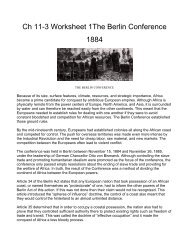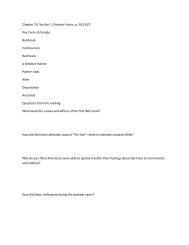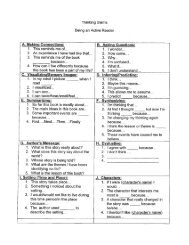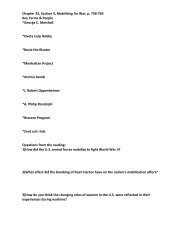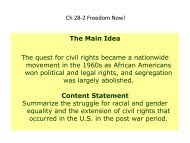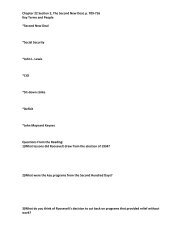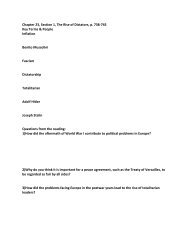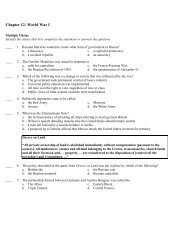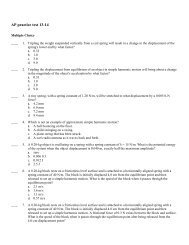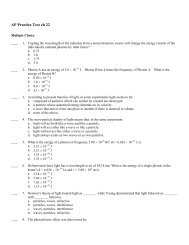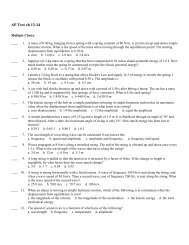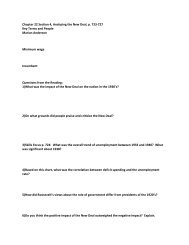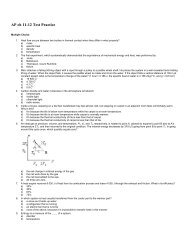Midterm practice
Midterm practice
Midterm practice
Create successful ePaper yourself
Turn your PDF publications into a flip-book with our unique Google optimized e-Paper software.
midterm study guide<br />
Multiple Choice<br />
____<br />
____<br />
1. In the steps of the scientific method, what is the next step after formulating and objectively testing<br />
hypotheses?<br />
a. interpreting results b. stating conclusions c. conducting experiments d. making observations and<br />
collecting data<br />
2. The radius of Earth is 6 370 000 m. Express this measurement in km in scientific notation with the correct<br />
number of significant digits.<br />
a. km b. km c. km d. km<br />
____ 3. Three values were obtained for the mass of a metal bar: 8.83 g; 8.84 g; 8.82 g. The known mass is 10.68 g.<br />
The values are<br />
a. accurate. b. precise. c. both accurate and precise. d. neither accurate nor precise.<br />
____<br />
4. Which of the following equations best describes the graph above?<br />
a. y = x + 1 b. y = x – 1 c. y = –x + 1 d. y = –x – 1<br />
____ 5. Which of the following expressions gives units of kg m s ?<br />
a. m x ( t) b. m ( x) ( t) c. m ( x) t d. ( t) m ( x)<br />
____<br />
____<br />
6. Which of the following units is the SI unit of velocity?<br />
a. meter b. meter second c. meter per second d. second per meter<br />
7. A baseball catcher throws a ball vertically upward and catches it in the same spot as it returns to the mitt. At<br />
what point in the ball’s path does it experience zero velocity and nonzero acceleration at the same time?
____<br />
____<br />
a. midway on the way up b. at the top of its path c. the instant it leaves the catcher’s hand d. the instant<br />
before it arrives in the catcher’s mitt<br />
8. Which of the following is a physical quantity that has a magnitude but no direction?<br />
a. vector b. scalar c. resultant d. frame of reference<br />
9. A football player runs in one direction to catch a pass, then turns and runs twice as fast in the opposite<br />
direction toward the goal line. Which of the following is a correct expression for the original velocity and the<br />
resulting velocity?<br />
a. –v player , –2v player b. v player , 2v player c. v player , –2v player d. 2v player , –v player<br />
____ 10. Which of the following is the tendency of an object to maintain its state of motion?<br />
a. acceleration b. inertia c. force d. velocity<br />
____ 11. A waitperson carrying a tray with a platter on it tips the tray at an angle of 12 below the horizontal. If the<br />
gravitational force on the platter is 5.0 N, what is the magnitude of the force parallel to the tray that tends to<br />
cause the platter to slide down the tray? (Disregard friction.)<br />
a. 0.42 N b. 1.0 N c. 4.9 N d. 5.0 N<br />
____ 12. The statement by Newton that for every action there is an equal but opposite reaction is which of his laws of<br />
motion?<br />
a. first b. second c. third d. fourth<br />
____ 13. A sled weighing 1.0 10 N is held in place on a frictionless 20.0 slope by a rope attached to a stake at the<br />
top. The rope is parallel to the slope. What is the normal force of the slope acting on the sled?<br />
a. 94 N b. 47 N c. 37 N d. 34 N<br />
____ 14. A crate is carried in a pickup truck traveling horizontally at 15.0 m/s. The truck applies the brakes for a<br />
distance of 28.7 m while stopping with uniform acceleration. What is the coefficient of static friction between<br />
the crate and the truck bed if the crate does not slide?<br />
a. 0.400 b. 0.365 c. 0.892 d. 0.656<br />
____ 15. In which of the following sentences is work used in the everyday sense of the word?<br />
a. Lifting a heavy bucket involves doing work on the bucket. b. The force of friction usually does negative<br />
work. c. Sam and Rachel worked hard pushing the car. d. Work is a physical quantity.<br />
____ 16. Which of the following formulas would be used to directly calculate the kinetic energy of an object with mass<br />
m bouncing up and down on a spring with spring constant k?<br />
a. b. c. d.<br />
____ 17. What are the units for a spring constant?<br />
a. N b. m c. N m d. N/m<br />
____ 18. If the displacement of a horizontal mass-spring system was doubled, the elastic potential energy in the system<br />
would change by a factor of<br />
a. 1/4. b. 1/2. c. 2. d. 4.<br />
____ 19. Which of the following equations is not an equation for power, P, in terms of work, W, displacement, d, time<br />
interval, t, force, F, and/or velocity, v?<br />
a. b. c. d.<br />
____ 20. Which of the following are not units of power?<br />
a. hp b. J c. W d. J s
____ 21. A roller coaster climbs up a hill at 4 m/s and then zips down the hill at 30 m/s. The momentum of the roller<br />
coaster<br />
a. is greater up the hill than down the hill. b. is greater down the hill than up the hill. c. remains the same<br />
throughout the ride. d. is zero throughout the ride.<br />
____ 22. A billiard ball collides with a second identical ball in an elastic head-on collision. What is the kinetic energy<br />
of the system after the collision compared with the kinetic energy before the collision?<br />
a. unchanged b. one-fourth as great c. two times as great d. four times as great<br />
____ 23. A ball is whirled on a string, then the string breaks. What causes the ball to move off in a straight line?<br />
a. centripetal acceleration b. centripetal force c. centrifugal force d. inertia<br />
____ 24. If you lift an apple from the ground to some point above the ground, the gravitational potential energy in the<br />
system increases. This potential energy is stored in<br />
a. the apple. b. Earth. c. both the apple and Earth. d. the gravitational field between Earth and the<br />
apple.<br />
____ 25. How would the speed of Earth’s orbit around the sun change if Earth’s distance from the sun increased by 4<br />
times?<br />
a. It would increase by a factor of 2. b. It would increase by a factor of 4. c. It would decrease by a factor<br />
of 2. d. The speed would not change.<br />
____ 26. A water bed that is 1.5 m wide and 2.5 m long weighs 1055 N. Assuming the entire lower surface of the bed<br />
is in contact with the floor, what is the pressure the bed exerts on the floor?<br />
a. 250 Pa b. 260 Pa c. 270 Pa d. 280 Pa<br />
____ 27. What does the difference between gauge pressure and absolute pressure equal?<br />
a. the pressure within the fluid b. the pressure at the surface of the fluid c. the pressure at the bottom of<br />
the fluid d. zero<br />
____ 28. The gauge pressure for the air in a balloon equals 1.01 10 Pa. If atmospheric pressure is equal to 1.01<br />
10 Pa, what is the absolute pressure of the air inside the balloon?<br />
a. 0 Pa b. 5.05 10 Pa c. 1.01 10 Pa d. 2.02 10 Pa<br />
____ 29. If the flow rate of a liquid is measured at 8.0 10 m /s going through a 20.0 m radius pipe, which of the<br />
following is the average fluid velocity in the pipe?<br />
a. 4.0 10 m/s b. 0.64 m/s c. 2.0 m/s d. 6.4 m/s<br />
____ 30. A water tunnel has a circular cross section where the diameter diminishes from 3.6 m to 1.2 m. If the velocity<br />
of water is 3.0 m/s in the larger part of the tunnel, what is the velocity of water in the smaller part of the<br />
tunnel?<br />
a. 9.0 m/s b. 18 m/s c. 27 m/s d. 54 m/s<br />
____ 31. Which of the following is proportional to the kinetic energy of atoms and molecules?<br />
a. elastic energy b. temperature c. potential energy d. thermal equilibrium<br />
____ 32. Which of the following is a form of kinetic energy that occurs within a molecule when the bonds are stretched<br />
or bent?<br />
a. translational b. rotational c. vibrational d. internal<br />
____ 33. What are the energies associated with atomic motion called?<br />
a. kinetic energy b. potential energy c. bond energy d. internal energy<br />
____ 34. The use of fiberglass insulation in the outer walls of a building is intended to minimize heat transfer through<br />
what process?
a. conduction b. radiation c. convection d. vaporization<br />
____ 35. Which of the following describes a substance in which the temperature and pressure remain constant while<br />
the substance experiences an inward transfer of energy?<br />
a. gas b. liquid c. solid d. substance undergoing a change of state<br />
____ 36. Which of the following is a thermodynamic process in which a system returns to the same conditions under<br />
which it started?<br />
a. an isovolumetric process b. an isothermal process c. a cyclic process d. an adiabatic process<br />
____ 37. Which of the following is not a way in which a cyclic process resembles an isothermal process?<br />
a. Energy can be transferred as work. b. Energy can be transferred as heat. c. The temperature of the<br />
system remains constant throughout the process. d. There is no net change in the internal energy of the<br />
system.<br />
____ 38. Which equation describes the net work done for a complete cycle of a heat engine?<br />
a. W = Q U b. W = Q Q c. W = Q Q d. W = P V<br />
____ 39. Imagine you could observe the individual atoms that make up a piece of matter and that you observe the<br />
motion of the atoms becoming more orderly. What can you assume about the system?<br />
a. It is gaining thermal energy. b. Its entropy is increasing. c. Its entropy is decreasing. d. Positive work<br />
is being done on the system.<br />
____ 40. A chunk of ice with a mass of 1 kg at 0°C melts and absorbs 3.33 10 J of heat in the process. Which best<br />
describes what happened to this system?<br />
a. Its entropy increased. b. Its entropy decreased. c. Its entropy remained constant. d. Work was<br />
converted to energy.<br />
Short Answer<br />
41. Convert g to kilograms using scientific notation.<br />
42. What quantity describes the difference between an object’s initial position and the object’s final position?<br />
43. What is the SI unit of acceleration?<br />
44. Why is the direction of free-fall acceleration usually negative?
The figure above shows the path of a ball tossed from a building. Air resistance is ignored.<br />
45. In the figure above, what would happen to the height of the ball’s path if it were launched with a lesser<br />
velocity?<br />
46. If two teams playing tug-of-war pull on a rope with equal but opposite forces, what is the net external force on<br />
the rope?<br />
47. In the following sentence, is the everyday meaning or the scientific meaning of work intended?<br />
A bulldozer does work lifting a load.<br />
48. What formula can be used to calculate work if the force acts at an angle to the displacement?<br />
49. You are analyzing the flight of a projectile through the air. What assumption do you have to make in order to<br />
use conservation of mechanical energy in your analysis?<br />
50. Two snowballs are traveling straight toward each other. One snowball has twice the mass of the other, but is<br />
moving at half the speed. The snowballs meet head-on in a perfectly inelastic collision. What is the total<br />
momentum of the system containing the two snowballs before the collision?<br />
51. Two horses are side by side on a carousel. Which has a greater tangential speed—the one closer to the center<br />
or the one farther from the center? Explain your answer.<br />
52. Use the concept of mechanical advantage to explain why, in a hydraulic lift, the smaller piston is pushed<br />
down a farther distance than the larger piston is raised.<br />
53. How does Archimedes’ principle relate to changes in pressure with depth?<br />
54. What does Bernoulli’s principle state will happen to the pressure in a fluid as the speed of the fluid increases?<br />
55. A pan of water at a temperature of 80 C is placed on a block of porcelain at a temperature of 15 C. What can<br />
you state about the temperatures of the objects when they are in thermal equilibrium?<br />
56. What is the specific heat capacity of a substance?<br />
57. A physics textbook is balanced on top of an inflated balloon on a cold morning. As the day passes, the<br />
temperature increases, the balloon expands, and the textbook rises. Is there a transfer of energy as heat? If so,<br />
what is it? Has any work been done? If so, on what?<br />
58. According to the first law of thermodynamics, how can the internal energy of a system be increased?
59. How is the conservation of a system’s internal energy mathematically expressed for an isothermal process?<br />
Explain your answer.<br />
60. Use the second law of thermodynamics and the equation for heat engine efficiency to show why efficiency<br />
must always be less than 1.<br />
Problem<br />
61. A stroller walks the first half of a straight 1.4 km trail at a steady pace of 1.7 m/s, east. He walks the second<br />
half at a constant stride of 0.37 m/s, east. What is his average velocity along the trail?<br />
62. While grazing, a caribou treks 136 m at 53.0 west of south, and then 129 m west. What is the caribou’s<br />
resultant displacement?<br />
63. A sled is pulled at a constant velocity across a horizontal snow surface. If a force of 4.0 10 N is being<br />
applied to the sled rope at an angle of 11 to the ground, what is the magnitude of the force of friction of the<br />
snow acting on the sled?<br />
64. Water flows over a section of Niagara Falls at a rate of 1.30 10 kg/s and falls 49.5 m. What is the power of<br />
the waterfall?<br />
65. A swimmer with a mass of 59 kg dives off a raft with a mass of 400 kg. If the swimmer’s speed is 3 m/s<br />
immediately after leaving the raft, what is the speed of the raft?<br />
66. Two ice-skaters, each with a mass of 50.0 kg, are stationary on a frictionless ice pond. One skater throws a<br />
0.90 kg ball with a speed of 2.0 m/s to the other skater, who catches it. What are the velocities of the skaters<br />
when the ball is caught?<br />
67. A 4.2 m board with a mass of 19 kg is pivoted at its center of gravity. A helium balloon attached 0.24 m from<br />
the left end of the board produces an upward force of 7.1 N. A 3.5 kg book is placed 0.74 m from the left end<br />
of the board, and another book of 1.7 kg is placed 0.77 m from the right end of the board. Find the torque on<br />
the board and the direction of rotation.<br />
68. A block of wood has a density of 0.820 g/cm and dimensions of 19.0 cm, 9.0 cm, and 4.0 cm. How large a<br />
force will just submerge the block in a vat of oil with a density 0.920 g/cm ?<br />
69. What is the increase in the internal energy per kilogram of water at the bottom of a 115 m waterfall, assuming<br />
that all of the initial potential energy is transferred as heat to the water? (g = 9.81 m/s )<br />
70. The piston and flywheel part of a steam engine takes in 993 J of energy as heat and expels 514 J of energy as<br />
heat. The internal energy of the system increases by 372 J during the process. Work is done by steam at a<br />
pressure of 2.21 10 Pa. If the radius of the piston is 4.14 10 m, how far is the piston displaced?



